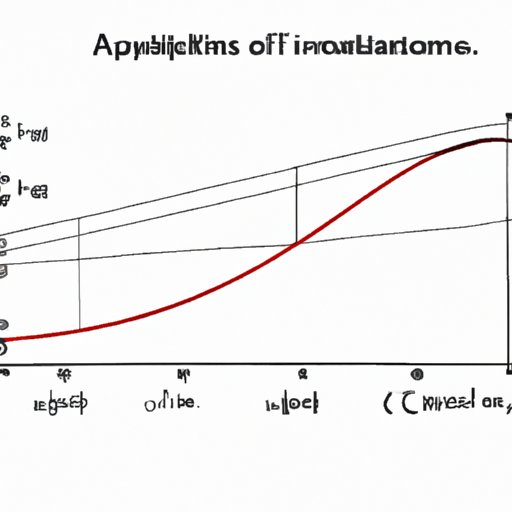Introduction
When it comes to understanding the behavior of a function, the horizontal asymptote can be a crucial piece of information. The horizontal asymptote represents the value that a function approaches as the input variable becomes infinitely large or infinitely small. Finding the horizontal asymptote can help you make predictions about the long-term behavior of a function and identify important features of its graph.
In this article, we’ll explore how to find the horizontal asymptote of a function. We’ll break down the math behind this concept and provide step-by-step instructions, useful strategies, tips and tricks, and a comprehensive approach. By the end of this guide, you’ll have the knowledge and tools you need to master the concept of the horizontal asymptote.
Mastering the Math: Discovering the Horizontal Asymptote
Let’s start by defining what a horizontal asymptote is and how it can be used to understand the behavior of a function. A horizontal asymptote is a horizontal line that a function approaches as the input variable (usually denoted by x) becomes infinitely large or infinitely small. If a function has a horizontal asymptote, its graph will approach that line as x approaches positive or negative infinity.
The importance of the horizontal asymptote lies in its ability to help us make predictions about the behavior of a function. If a function has a horizontal asymptote, we can use it to determine whether the function is increasing or decreasing as the input variable becomes infinitely large or small. We can also use it to identify the end behavior of the function, which can be crucial for solving problems in calculus and other branches of math.
An important concept to understand in relation to the horizontal asymptote is the limit. The limit of a function at a certain value represents the value that the function approaches as the input variable approaches that value. In other words, it represents the behavior of the function as it gets closer and closer to that value. When we talk about the horizontal asymptote, we are interested in the limit of the function as x approaches positive or negative infinity.
Breaking Down the Basics: A Step-by-Step Guide to Finding the Horizontal Asymptote
Now that we have a basic understanding of what a horizontal asymptote is and how it relates to limits, let’s explore how to find the horizontal asymptote of a function. The process can be broken down into the following steps:
- Determine the degree of the numerator and denominator of the function.
- Divide the numerator and denominator by the highest power of x.
- Simplify the resulting expression.
- Identify the horizontal asymptote.
Let’s look at an example to illustrate this process. Consider the function:
f(x) = (3x2 + 2x + 1)/(x2 – 4)
The degree of the numerator is 2, and the degree of the denominator is also 2. Therefore, we’ll divide both the numerator and denominator by x2:
f(x) = (3 + 2/x + 1/x2)/(1 – 4/x2)
By simplifying this expression, we get:
f(x) = (3/x2) * (1 + 2/3x + 1/3x2)/(1 – 4/x2)
As x becomes infinitely large or small, the term 4/x2 becomes negligible, and the function approaches:
f(x) = (3/x2) * (1 + 2/3x + 1/3x2)/(1)
The horizontal asymptote of this function is y = 0, since the numerator approaches 0 as x becomes infinitely large or small.
Navigating the Limits: Strategies for Finding the Horizontal Asymptote
While the step-by-step guide we just provided can be a useful method for finding the horizontal asymptote, it may not always be the most efficient or practical approach. In this section, we’ll explore some different strategies you can use to find the horizontal asymptote of a function.
Using the Graph
One method for finding the horizontal asymptote is to use the graph of the function. If you graph the function, you can look for the value that the function approaches as the input variable becomes infinitely large or small.
For example, consider the function:
f(x) = (x2 – 3)/(2x2 + 5)
If we graph this function, we can see that it approaches y = 1/2 as x becomes infinitely large or small:
Using Algebraic Properties of the Function
Another method for finding the horizontal asymptote is to use algebraic properties of the function. For example, if the degree of the numerator is less than the degree of the denominator, the horizontal asymptote will be y = 0. If the degree of the numerator is equal to the degree of the denominator, the horizontal asymptote will be the ratio of the leading coefficients of the numerator and denominator. If the degree of the numerator is greater than the degree of the denominator, there is no horizontal asymptote.
For example, consider the function:
f(x) = (5x3 – 2x + 1)/(3x3 + 7x2 – x)
The degree of the numerator is 3, and the degree of the denominator is also 3. Therefore, the horizontal asymptote will be the ratio of the leading coefficients of the numerator and denominator:
y = 5/3
Unveiling the Mystery: Tips and Tricks for Identifying the Horizontal Asymptote
While knowing the step-by-step process and different strategies for finding the horizontal asymptote is important, there are also some useful tips and tricks that can help make the process easier. Here are a few:
- Check for holes in the graph of the function. If there is a hole on the line that the function appears to be approaching, it may not have a horizontal asymptote.
- Remember that the horizontal asymptote is the “end behavior” of the function, so it is often helpful to think about what happens to the function as x becomes infinitely large or small.
- If you are graphing the function to find the horizontal asymptote, make sure to check multiple points on the graph to confirm your answer.
- Watch out for vertical asymptotes, which can occur when the denominator of the function equals zero.
The Ultimate Guide to Finding the Horizontal Asymptote: A Comprehensive Approach
Now that we’ve covered some different methods and tips for finding the horizontal asymptote, let’s provide a comprehensive approach that combines these strategies into a step-by-step process:
- Determine the degree of the numerator and denominator of the function.
- If the degree of the numerator is less than the degree of the denominator, the horizontal asymptote is y = 0. If the degree of the numerator is greater than the degree of the denominator, there is no horizontal asymptote.
- If the degree of the numerator is equal to the degree of the denominator, divide the numerator and denominator by the highest power of x.
- Simplify the resulting expression and identify the ratio of the leading coefficients as the horizontal asymptote.
- If you are unsure about your answer or want to confirm it, graph the function and look for the value that the function approaches as the input variable becomes infinitely large or small.
From Equations to Graphs: Methods for Locating the Horizontal Asymptote
So far, we’ve focused on how to find the horizontal asymptote from the equation of a function. However, it is also important to know how to locate the horizontal asymptote on the graph of a function. The horizontal asymptote can be thought of as a line that the function gets closer and closer to as x becomes infinitely large or small.
To locate the horizontal asymptote on a graph, you can look for the straight line that the graph approaches as x becomes infinitely large or small. You can also use the equation of the horizontal asymptote to help you draw the graph accurately.

Cracking the Code: Understanding the Concept of the Horizontal Asymptote
Now that we’ve covered all the details of how to find the horizontal asymptote, it’s important to emphasize the importance of understanding the concept itself. The horizontal asymptote is a key concept in calculus and other areas of math, and having a solid understanding of it can help you make predictions about the behavior of functions, solve complex problems, and gain a deeper understanding of mathematical concepts as a whole.
By practicing finding horizontal asymptotes using different strategies and techniques, you can develop a mastery of the concept and become more confident in your math skills.
Conclusion
In this article, we’ve explored in depth how to find the horizontal asymptote of a function. We provided a step-by-step guide, different strategies, tips and tricks, and a comprehensive approach. We also discussed how to locate the horizontal asymptote on a graph and emphasized the importance of understanding the concept of the horizontal asymptote.
With this information, you now have the knowledge and tools you need to confidently approach problems related to the horizontal asymptote. Remember to practice using different methods to find the horizontal asymptote and seek help if you need it. By developing a mastery of this concept, you’ll be setting yourself up for success in calculus and other areas of math.

